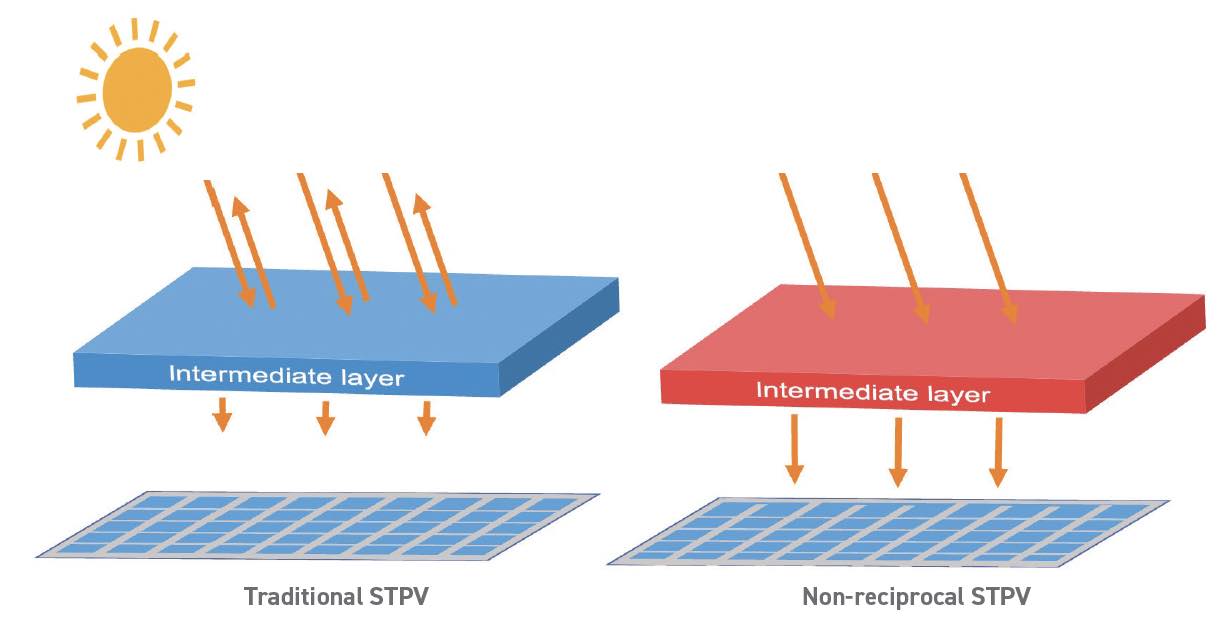A non-reciprocal solar thermophotovoltaic system (NSTPV) has been developed that, in theory, can harvest solar energy and convert it to electricity at a higher efficiency.
The NSTPV is able to direct all incoming solar energy for use as electricity.
Minimization of entropy is an important factor in boosting efficiency.
Capturing and converting solar energy into electricity remains as one of the most sustainable approaches for power generation. Efforts are continuing to maximize the efficiency of solar cells.
Harvesting energy of all types in a specific environment is becoming an increasingly important method particularly in remote locations. In a past TLT article,
1 researchers developed a micro-biophotovoltaic cell that takes advantage of the ability of three bacteria species to use photosynthesis to capture light and then generate electricity through an electropolymerization process. To achieve this goal, the three bacteria species are vertically stacked in a typical microbial fuel cell. This method takes advantage of how each bacteria species generates power. These biobatteries can be stacked in series and parallel to maximize power output.
Single-junction solar cells, the primary way for capturing solar energy, are widely used but have limitations. Bo Zhao, Kalsi assistant professor of mechanical engineering at the University of Houston in Houston, Texas, says, “Solar cells only use a portion of the solar spectrum to generate electricity which limits their effectiveness. When photons reach the solar cell, they will interact with the cell to produce high energy electron-hole pairs. But the problem is this process only occurs if the photon has the right energy. The solar cell cannot use photons that have less energy than the energy required to produce the electron-hole pairs. On the other hand, for those photons with more than the needed energy, the solar cell will only use the amount it can tolerate, and the rest left over is wasted.”
Most of the energy used originates from the visible light and infrared portions of the solar spectrum.
To compensate for the inefficiency of solar cells, a new approach in the form of solar thermophotovoltaic (STPV) systems has been developed. Zhao says, “STPVs are a more effective way to achieve solar harvesting by facilitating the use of the entire spectrum of solar energy produced by the sun. They function by placing an intermediate layer between the sun and the STPV cell. This layer has a top section that absorbs sunlight while heating up. A bottom section is nanostructured and emits photons with energy levels that the STPV cell can convert into electricity.”
The problem with conventional STPVs is their inherent efficiency deficit, according to Zhao. He says, “STPVs exhibit efficiency values that are 8% lower than theoretical. This issue is due to the top section of the intermediate layer absorbing and then emitting some of the absorbed photons not to the SPTV cell but back out into the environment where they are lost. This process is known as sending back emissions toward the sun.”
Zhao points out that the loss of this emission is significant because the temperature of the top section of the intermediate layer can reach as high as 2,500 K for efficient operations.
A new type of STPV has now been developed in concept that eliminates back emissions and can theoretically increase the efficiency closer to theoretical.
Non-reciprocal STPV
Zhao and his colleague, Sina Jafari Ghalekohneh, graduate student at the University of Houston, are introducing a non-reciprocal STPV (NSTPV) system that, in theory, can conduct solar energy harvesting up to the theoretical, thermodynamic efficiency limit of 93.3%. This figure is the highest possible efficiency for converting solar energy to electricity.
He says, “The key to the NSTPV is that the intermediate layer directs all incoming solar energy to the backside of the unit and then onto the STPV cell for conversion into electricity. No emissions move back toward the sun
(see Figure 1). An ideal intermediate layer will have a top section that fully absorbs all wavelengths of solar energy. The bottom section then sends a narrowband emission radiating photons that can be utilized efficiently by the solar cell.”
 Figure 1. The contrast between a traditional solar thermophotovoltaic system (STPV, on the left) and the non-reciprocal solar thermophotovoltaic system (NSTPV, on the right) is shown. No energy is emitted back to the sun with the NSTPV leading to an increase in efficiency. Figure courtesy of the University of Houston.
Figure 1. The contrast between a traditional solar thermophotovoltaic system (STPV, on the left) and the non-reciprocal solar thermophotovoltaic system (NSTPV, on the right) is shown. No energy is emitted back to the sun with the NSTPV leading to an increase in efficiency. Figure courtesy of the University of Houston.
In a thermodynamic analysis of the NSTPV system, the researchers found that minimization of entropy generation is an important factor in boosting efficiency. Zhao says, “Entropy generated by the NSPTV can be reduced to zero because the solar energy can be perfectly transmitted.”
Zhao envisions that a NSTPV system can transmit electricity to an economical thermal energy storage unit making it feasible for solar energy to be available for electricity generation even at night. Zhao says, “A NSTPV system should be able to improve the productivity of power plants.”
With the concept having been developed theoretically, the next step is to find a suitable material for use in the intermediate layer. Zhao says, “There is a significant effort underway to find an engineered nanostructure that can be used in the NSTPV and remain stable under high temperature conditions. Once a material is identified, testing can be conducted to evaluate its performance.”
Additional information can be found in a recent article
2 or by contacting Zhao at
bzhao8@uh.edu.
REFERENCES
1.
Canter, N. (2022), “Biobatteries,” TLT,
78 (10), pp. 16-18. Available
here.
2.
Ghalekohneh, S. and Zhao, B. (2022), “Nonreciprocal solar thermophotovoltaics,”
Physical Review Applied, 18 (3), 034083.